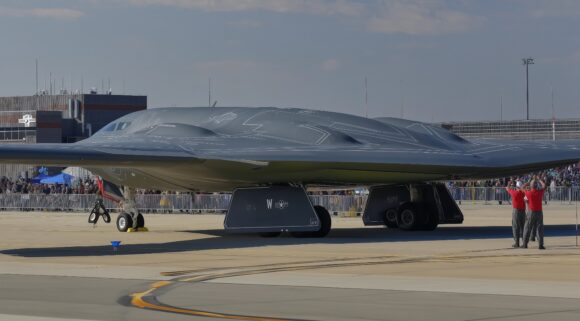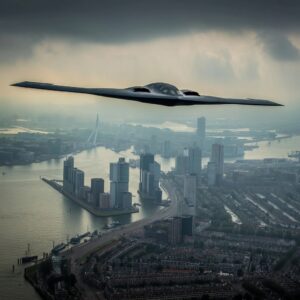
The B-2 Bomber, officially known as the B-2 Spirit, is a long-range, strategic stealth bomber developed by Northrop Grumman for the United States Air Force. Designed during the Cold War to penetrate heavily defended airspace, the B-2 is one of the most advanced and expensive military aircraft ever built. With its first flight on July 17, 1989, and official introduction into service on January 1, 1997, only 21 units were produced—20 operational aircraft and 1 test unit—at a staggering cost of approximately $2 billion per aircraft.
The B-2 features a distinctive flying wing design, lacking a vertical tail and built with radar-absorbing materials, making it extremely difficult to detect on radar. It can carry up to 40,000 pounds of both conventional and nuclear weapons, including JDAM (Joint Direct Attack Munitions), B61 or B83 nuclear bombs, and AGM-129 ACM (Advanced Cruise Missiles). Its unrefueled range is approximately 6,000 nautical miles (11,000 km), but with aerial refueling, the B-2 is capable of reaching targets anywhere in the world and returning to its base—often without ever landing in a combat zone.
The B-2 Spirit is one of only three stealth bombers ever created, alongside the retired F-117 Nighthawk and the newer, in-development B-21 Raider. Unlike traditional bombers such as the B-52 Stratofortress—which remains in service due to upgrades and versatility—the B-2 is not designed for carpet bombing. Its real power lies in its ability to deliver devastating precision strikes with stealth, bypassing even the most advanced air defense systems. It is capable of targeting hardened bunkers, nuclear facilities, command centers, and other high-value installations with surprise and accuracy, making it a critical component of the U.S. nuclear triad and global strike capability.
However, the B-2 is rarely used due to its extremely high operational cost (around $130,000 per flight hour) and limited availability. It is reserved for missions where stealth is absolutely essential, targets are deeply protected, or geopolitical signaling is a factor. Despite its age, the B-2 remains a strategic asset, capable of flying from Whiteman Air Force Base in Missouri to strike distant targets and return without detection.

The B-2 has been deployed in several key military operations. In 1999, during the Kosovo War, it made its combat debut, flying directly from the U.S. to Serbia and back, dropping 80 precision bombs in a single mission.
In 2001, it was used in the early stages of the Afghanistan war, striking Taliban command and air defense sites.
In the 2003 Iraq War, B-2s delivered conventional bunker-busting bombs on leadership compounds and early warning systems. In 2011, as part of NATO’s Operation Odyssey Dawn in Libya, B-2s carried out 25-hour missions to disable Libyan air defenses and runways with high-precision JDAMs.
Most recently, on June 22, 2025, B-2 bombers played a pivotal role in “Operation Midnight Hammer”, a major U.S. airstrike against Iranian nuclear facilities at Fordow, Natanz, and Isfahan. The bombers dropped bunker-buster munitions, inflicting severe damage to Iran’s nuclear enrichment infrastructure. The Pentagon confirmed the success of the mission, while Iran denounced it as a violation of international law. The operation marked a significant escalation in the ongoing Israel-Iran conflict and triggered widespread international concern over the potential for broader war in the Middle East.




